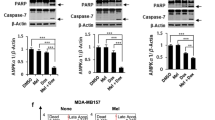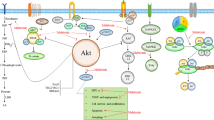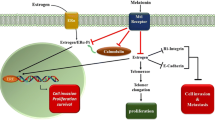Abstract
It has been established that melatonin (Mlt) and retinoic acid, individually, inhibit the proliferation of the estrogen receptor-alpha (ERα)-positive MCF-7 breast cancer cell line. Our laboratory has previously demonstrated that Mlt and all-trans-retinoic acid (atRA) not only inhibit the proliferation, but also induce apoptosis of MCF-7 cells when used in a sequential regimen of Mlt followed 24 h later by atRA. Using this same MCF-7 breast cancer cell line, we investigated the potential pathways through which apoptosis is being induced. We found that treatment of MCF-7 cells with Mlt for 24 h before the addition of atRA decreased the protein levels of the death suppressor, Bcl-2, and increased, although with different time courses, the levels of the death promoters, Bax and Bak; however, there was no change in the levels of the tumor suppressor gene, p53. MCF-7 cells treated sequentially with Mlt and atRA also demonstrated an enhanced sensitivity to the apoptotic effects of atRA, which did not appear to be due to increased expression of the retinoic acid receptors, RARα or RXRα, but rather to enhanced transcriptional activity of the RARα. These data suggest that the sequential treatment regimen of Mlt and atRA may induce apoptosis by modulation of members of the Bcl-2 family of proteins. Thus, this combinatorial regimen, which reduces the concentration of atRA needed for clinical efficacy while enhancing its anti-tumorigenic activity, could be of great therapeutic benefit, and may, in fact, specifically induce the regression of established breast tumors due to its apoptosis-promoting effects.
Similar content being viewed by others
References
Blask DE, Pelletier DB, Hill SM, Lemus-Wilson A, Grosso DS, Wilson ST, Wise ME: Pineal melatonin inhibition of tumor promotion in the N-nitroso-N-methylurea model of mammary carcinogenesis: potential involvement of antiestrogenic mechanisms in vivo. J Cancer Res Clin Oncol 117: 526–532, 1991
Hill SM, Spriggs LL, Simon MA, Muraoka H, Blask DE: The growth inhibitory action of melatonin on human breast cancer cells is linked to the estrogen response system. Cancer Lett 64: 249–256, 1992
Lacroix A, Lippman ME: Binding of retinoids to human breast cancer cell lines and their effects on cell growth. J Clin Invest 65: 586–591, 1980
Lotan R: Different susceptibilities of human melanoma and breast carcinoma cell lines to retinoic acid-induced growth inhibition. Cancer Res 39: 1014–1019, 1979
Eck KM, Yuan L, Duffy L, Ram PT, Ayettey S, Chen I, Cohn CS, Reed JC, Hill SM: A sequential treatment regimen with melatonin and all-trans retinoic acid induces apoptosis in MCF-7 tumour cells. Br J Cancer 77: 2129–2137, 1998
Manglesdorf DJ, Thummel C, Beato M, Herrlich P, Schutz G, Umesono K, Blumberg B, Kastner P, Mark M, Chambon P, Evans RM: The nuclear receptor superfamily: the second decade. Cell 83: 835–839, 1995
Levin A, Sturzenbecker LJ, Kazner S, Bosakowski T, Huselton C, Allenby G, Speck J, Kratzeisen C, Rosenberger M, Lovey A, Grippo JF: 9-cis retinoic acid stereoisomer binds and activates the nuclear receptor RXRa. Nature (London) 355: 359–361, 1992
Zhang X-K, Lehmann J, Hoffmann B, Dawson M, Cameron J, Graupner G, Hermann T, Tran P, Pfahl M: Homodimer formation of retinoid X receptor induced by 9-cis retinoic acid. Nature (London) 358: 587–591, 1992
Kliewer SA, Umesono K, Mangelsdorf D, Evans RM: Retinoid X receptor interacts with nuclear receptors in retinoic acid, thyroid hormone, and vitamin D3 signaling. Nature 355: 446–449, 1992
Yu VC, Delsert C, Andersen B, Holloway JM, Devary OV, Naar AM, Kim SY, Boutin J-M, Glass CK, Rosenfeld MG: RXRB: A co-regulator that enhances binding of retinoic acid, thyroid hormone, and vitamin receptors to their cognate response elements. Cell 67: 1251-1266, 1991
Oltvai ZN, Millman CL, Korsmeyer SJ: Bcl-2 heterodimerizes in vivo with a conserved homolog, Bax, that accelerates programmed cell death. Cell 74: 609–619, 1993
Wang TY, Phang JM: Effects of estrogen on apoptotic pathways in human breast cancer cell line MCF-7. Cancer Res 55: 2487–2489, 1995
Hollstein M, Sidransky D, Vogelstein B, Harris C: p53 mutations in human cancers. Science 253: 49–53, 1991
Miyashita T, Krajewski S, Krajewska M, Wang HG, Lin HK, Liebermann DA, Hoffman B, Reed JC: Tumor suppressor p53 is a regulator of bcl-2 and bax gene expression in vitro and in vivo. Oncogene 9: 1799–1805, 1994
Miyashita T, Reed JC: Tumor suppressor p53 is a direct transcriptional activator of the human bax gene. Cell 80: 293–299, 1995
Haldar S, Negrini M, Monne M, Sabbioni S, Croce CM: Down-regulation of bcl-2 by p53 in breast cancer cells. Cancer Res 54: 2095–2097, 1994
Han J, Sabbatini P, Perez D, Rao L, Modha D, White E: The E1B 19K protein blocks apoptosis by interacting with and inhibiting the p53-inducible and death-promoting Bax protein. Genes Dev 10: 461–477, 1996
Chiou S-K, Rao L, White E: Bcl-2 blocks p53-dependent apoptosis. Mol Cell Biol 14: 2556–2563, 1994
Telford WG, King LE, Fraker PJ: Comparative evaluation of several DNA binding dyes in the detection of apoptosisassociated chromatin degradation by flow cytometry. Cytometry 13: 137–143, 1992
Lizard G, Fournel S, Genestier L, Dhedin N, Chaput C, Flacher M, Mutin M, Panaye G, Revillard J-P: Kinetics of plasma membrane and mitochondrial alterations in cells undergoing apoptosis. Cytometry 21: 275–283, 1995
Hill SM, Blask DE: Effects of the pineal hormone melatonin on the proliferation and morphological characteristics of human breast cancer cells (MCF-7) in culture. Cancer Res 48: 6121–6126, 1988
Blask DE, Pelletier DB, Hill SM, Lemus-Wilson A, Grosso DS, Wilson ST, Wise ME: Pineal melatonin inhibition of tumor promotion in the N-nitroso-N-methylurea model of mammary carcinogenesis: potential involvement of antiestrogenic mechanisms in vivo. J Cancer Res Clin Oncol 117: 526–532, 1991
Toma S, Isnardi L, Farro P, Dastoli G, De Francisci E, Riccardi L, Palumbo R, Bollag W: Effects of all-trans-retinoic acid and 13-cis-retinoic acid on breast cancer cell lines: growth inhibition and apoptosis induction. Int J Cancer 70: 619–627, 1997
Mangiarotti R, Danova M, Alberici R, Pellicciari C: All-trans retinoic acid (ATRA)-induced apoptosis is preceded by G1 arrest in human MCF-7 breast cancer cells. Br J Cancer 77: 186–191, 1998
Youmell M, Park SJ, Basu S, Price BD: Regulation of the p53 protein by protein kinase Ca and protein kinase Cd. Biochem Biophys Res Comm 245: 514–518, 1998
Sheikh MS, Shao Z-M, Chen J-C, Hussein A, Jetten AM, Fontana JA: Estrogen receptor negative breast cancer cells transfected with estrogen receptor exhibit increased RARα gene expression and sensitivity to growth inhibition by retinoic acid. J Cell Biochem 53: 394–404, 1993
van der Burg B, van der Leede BM, Kwakkenbos-Isbrucker L, Salverda S, deLaat SW, van der Saag PT: Retinoic acid resistance of estradiol-independent breast cancer cells coincides with diminished retinoic receptor function. Mol Cell Endocrinol 91: 149–157, 1993
Molis TM, Spriggs LL, Hill SM: Modulation of estrogen receptor mRNA expression by melatonin in MCF-7 human breast cancer cells. Mol Endocrinol 8: 1681–1690, 1994
Ram PT, Kiefer T, Silverman M, Song Y, Brown GM, Hill SM: Estrogen receptor transactivation in MCF-7 breast cancer cells by melatonin and growth factors. Mol Cell Endocrinol 141: 53–64, 1998
Becker-Andre M, Wiesenberg I, Schaeren-Wiemers N, Andre E, Missbach M, Saurat J-H, Carlberg C: Pineal gland hormone melatonin binds and activates an orphan of the nuclear receptor superfamily. J Biol Chem 269: 28531–28534, 1994
Steinhilber D, Brungs M, Werz O, Wiesenberg I, Danielsson C, Kahlen J-P, Nayeri S, Schrädder M, Carlberg C: The nuclear receptor for melatonin represses 5-lipoxygenase gene expression in human B lymphocytes. J Biol Chem 270: 7037–7040, 1995
Tini M, Fraser RA, Gigù ere V: Functional interactions between retinoic acid receptors-related orphan nuclear receptor (RORα) and the retinoic acid receptors in the regulation of the gF-crystalline promoter. J Biol Chem 270: 20156–20161, 1995
Ebisawa T, Karne S, Lerner MR, Reppert SM: Expression cloning of a high-affinity melatonin receptor from Xenopus dermal melanophores. Proc Natl Acad Sci USA 91: 6133–6137, 1994
Reppert SM, Godson C, Mahle CD, Weaver DR, Slaugenhaupt SA, Gusella JF: Molecular characterization of a second melatonin receptor expressed in human retina and brain: the Mel1B melatonin receptor. Proc Natl Acad Sci USA 92: 8734–8738, 1995
Etheridge K, Calabretta C, Jaeger R: Melatonin effects on cyclic AMP in MCF-7 breast cancer cells. (Abstract) Exp Biol 6401: A1106, 1998
Huggenvik JI, Collard MW, Kim Y-W, Sharma RP: Modification of the retinoic acid signaling pathway by the catalytic subunit of protein kinase A. Mol Endocrinol 7: 543–550, 1993
Lefebvre P, Gaub M-P, Tahayato A, Rochette-Egly C, Formstecher P: Protein phosphatases 1 and 2A regulate the transcriptional and DNA binding activities of retinoic acid receptors. J Biol Chem 270: 10806–10816, 1995
Author information
Authors and Affiliations
Rights and permissions
About this article
Cite this article
Eck-Enriquez, K., Kiefer, *.E.T., Spriggs, L.L. et al. Pathways through which a regimen of melatonin and retinoic acid induces apoptosis in MCF-7 human breast cancer cells. Breast Cancer Res Treat 61, 229–239 (2000). https://doi.org/10.1023/A:1006442017658
Issue Date:
DOI: https://doi.org/10.1023/A:1006442017658




